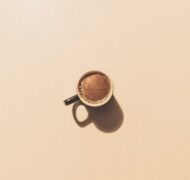Coffee Drinking
Book / Produced by partner of TOW
Coffee is more than a beverage, more than the most popular hot drink consumed throughout the world and more than a major industry that affects the economies of many Third World countries. Drinking coffee is integral to our way of life, a significant social and cultural phenomenon.
The Origins and Spread of Coffee
Around a.d. 600 coffee was found growing in Ethiopia. Initially it was rolled with fat into little balls and eaten. Several centuries later it appeared in Arabia under the name quawha, meaning “that which enables you to do without something.” Steeped in water, it was regarded as a tasty drink and as possessing recuperative powers. For a long time its attractions were kept relatively secret. Mocha was the first port where it became more freely available.
By the early seventeenth century coffee had spread eastward to India and beyond, and westward to the Caribbean and Latin America. The first coffeehouse in England was set up in 1637. It was patronized by the elite of society and within thirty years had many imitators. The Dutch introduced coffee to America, though it was only after the Boston Tea Party that it became the preferred drink there. As a result of mass production and the invention of instant coffee in the twentieth century, coffee became the most popular drink in most Western countries. The growing, harvesting, processing and distributing of coffee is now a huge industry. It is dominated by global corporations that often exploit workers in Third World countries, influence their economies in ways that are not always beneficial and effect cut-price deals for affluent nations with very large markets.
The Benefits of Coffee
Already in the seventeenth century coffeehouses became known as “penny universities,” where, for the payment of a relatively small sum, a person could take part in interesting social, intellectual and political discussion. In nineteenth-century Europe such places were often the seedbeds of democratic or revolutionary change. Coffee shops have long been a favorite haunt of artists and creative people. They have also been the setting for a great deal of business and commercial activity.
Offering someone a drink of coffee is also a mark of hospitality and helps create an atmosphere that puts people at ease. Why else do we so often offer or accept a cup of coffee even though we may not need anything to drink? In his poem “White with Two Sugars Please” the English poet Steve Turner refers to other functions or dimensions of this drink. Coffee, he says, can give you a legal shot of energy when you are feeling drowsy. It can help you pass time when waiting for the weather to clear. It is “something you can dangle your lips in when conversation is scarce.” It helps friendships develop and is always a good excuse to stay longer. Coffee is a universal language, a kind of multiracial, multilingual, multicultural Esperanto enjoyed by people of all ages. “Yes,” he concludes, “there’s something quite religious about coffee.”
At the personal level, people generally find that coffee enhances concentration and boosts energy. This is because caffeine is a mild central nervous stimulant. A 1994 study demonstrated that caffeine intake improved performance on semantic memory, logical reasoning, recall and memory recognition tests. For some tasks it gave people more energy than eating breakfast. On the other hand, there is no proof that it enhances creativity, and its effects are only temporary. Its stimulant effect leads many people to avoid it or drink it before bedtime only in a decaffeinated form. Others, however, find that coffee helps them relax, even sleep. This may have more to do with its warmth or with the fact that it signals a time to unwind. Caffeine can also help minimize the discomfort of migraine headaches and overcome dizziness in those who have low blood pressure by raising its level.
The creation of places specifically for drinking coffee has many benefits. They provide a welcoming, convivial space alongside or between the home and the workplace. Though not alone in doing this—bars, diners, beauty parlors and to some extent shopping malls play a similar role—they are less expensive and avoid the problems created by alcoholism or consumerism in some other so-called third places. Coffee shops provide an inclusive and level playing ground for people who are otherwise typecast by position, class, race or gender. In them people can shrug off their main domestic and work-related responsibilities, let go of some of their inhibitions and relax. They can socialize with others in spontaneous ways undetermined by a set agenda. In these places spirits are generally lifted—on average people laugh nine times as much in such a setting as elsewhere during the day—which means they have therapeutic value. Over time, long-term relationships involving real acceptance of others have been built up among those who visit the same coffee shop on a regular basis.
The Disadvantages of Coffee
Unfortunately, largely because of its caffeine content, coffee drinking can become addictive (see Addiction). Like chain-smokers, some people drink coffee continuously throughout the day. Also, depending on certain physiological conditions, coffee can sometimes have adverse effects. For example, people with high blood pressure can become overstimulated and should therefore limit their intake to two cups a day.
Since there is a proven link between imbibing caffeine and difficulty in conception, women wishing to become pregnant should minimize or eliminate coffee intake. There is also a link between very high coffee intake and an increased risk of miscarriage. Breast-feeding mothers should drink little coffee so that they do not overstimulate their babies. Anyone suffering from anxiety or panic disorder problems should cut back on coffee, as should those with ulcers, coronary artery disease or high cholesterol levels.
Some medical opinion specifies the number of cups of different kinds of coffee people should drink a day—generally somewhere between three to six caffeinated drinks a day. As mentioned above, the difficulty is that people’s toleration of caffeine depends on other factors and that caffeine appears in many other beverages, such as tea, soda, candy and even some over-the-counter medicines. The secret seems to be developing a less pressured lifestyle, an awareness of the way our body and nervous system react and, as in so many other areas, taking things in moderation.
» See also: Addiction
» See also: Eating
» See also: Hospitality
» See also: Sugar/Sugary
Resources and References
R. Hattox, Coffee and Coffeehouses: The Origins of a Social Beverage in the Medieval Near East (Seattle: University of Washington, 1985); C. Katona and T. Katona, The Coffee Book (San Leandro, Calif.: Bristol, 1992); R. Oldenburg, The Great Good Place: Coffee Bars (New York: Paragon Place, 1989); S. Turner, Up to Date: Poems 1968-1982 (London: Hodder & Stoughton, 1982).
—Robert Banks





